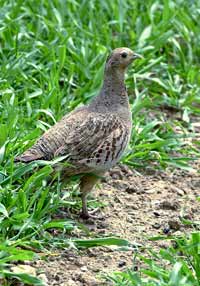On-farm measures to increase grey partridge numbers

A key aim of the Campaign for the Farmed Environment is to promote wildlife. In the second in this CFE series, Louise Impey looks at efforts to increase grey partridge numbers
Grey partridges are getting all the help they need at Wyken Hall Estate in Suffolk, but their conservation is proving to be a challenge.
Agri-environment schemes occupy 53 of the 443ha at Wyken Hall, Stanton, near Bury St Edmunds, but the provision of suitable habitats is not the only thing that’s working in the bird’s favour.
A very varied rotation, which includes spring crops and roots, together with predator control for six months of the year and some winter feeding, mean that the partridge is being given assistance at every stage of its life cycle.
The lighter sandy loam soils that form half of the estate are preferred by the partridges, explains owner Sir Kenneth Carlisle, who counted 10 pairs of greys this spring. “I’ve only glimpsed one covey since then, but we’ve still got potato and sugar beet crops for them to hide in, so they could be there.”
The adoption of both ELS and HLS across the estate has allowed him to develop a number of habitats, in an effort to provide the cover, nesting sites, food and shelter that the species requires. In-field options have been important, both for partridges and other farmland birds, and have worked well with commercial farming activities.
All of the arable land at Wyken is contract farmed by Will Reed. Cropping includes winter and spring cereals, winter beans, sugar beet, potatoes and onions, while a further 65ha is ancient SSSI woodland.
Since becoming part of the East Anglian Grey Partridge Group, Sir Kenneth and Mr Reed have worked together on a number of conservation measures.
Large arable fields have been divided by beetle banks, 6m unharvested cereal headlands are used alongside cereal crops and wild bird seed mixes provide both protection from predators and a valuable source of food.
In addition, over wintered stubbles, undersown with mustard, offer the residual cover needed when the coveys are breaking up, while summer fallow – originally put in to encourage lapwings – provides good cover for the broods as the season progresses.
“Losses of birds in January and February, when they are pairing up, can be high. It’s the time when they need protection from sparrowhawks, which is where the cover provided by the wild bird seed mixes plays a vital role,” says Sir Kenneth.
The territorial nature of the partridge means that a margin or environmental feature can only be of benefit to one pair of birds, explains Dr Roger Draycott of the Game and Wildlife Conservation Trust.
“They don’t like sharing. So it’s important to have options in every field. That’s why dividing big fields works so well.”
Partridges are not mobile when the chicks are small, he adds. “So there must be insects close to the nest site.”
This is where the unharvested cereal headlands can help, continues Dr Draycott. “In the spring and summer, they’re a vital source of insect food. In the autumn and winter, they provide seed for the adult birds. And, of course, they provide cover all year round.”
Ground intended for summer fallow is cultivated until mid-March, after which time it’s left to provide a nesting site for lapwings. The subsequent regrowth is of great benefit to partridges, providing further shelter for broods.
Winter feeding via hoppers is carried out, with Sir Kenneth planning to extend it into the spring, on the advice of the GWCT.
“The partridge’s spring diet of cereal shoot tips is high in protein, but low in energy,” says Dr Draycott. “They need energy-rich food to lay eggs, so giving them some grain at this time works well.”
Research has shown that nesting success is improved by between seven- and eight-fold with spring feeding, with chick numbers rising by eight times.
“It’s particularly important in years when it’s wet in May, as that can devastate chick survival. Partridges will re-nest if they are in good condition.”
As one pair of birds is associated with each hopper, it’s necessary to provide one hopper per territory, he adds.
Panel – grey partridge numbers
The 2010 target to have 90,000 pairs of grey partridges in the UK has proved to be too high, despite the best efforts of many farmers and landowners, reports Roger Draycott of the Game and Wildlife Conservation Trust.
“Nationally, the bird is still in decline. According to our records, there are close to 50,000 pairs.”
But it’s not all bad news, he stresses. “On our Partridge Count Scheme farm sites, numbers have shown a 7% year-on-year increase. So it is possible to make a difference.”
•For more on CFE, visit our dedicated web page at www.fwi.co.uk/cfe

